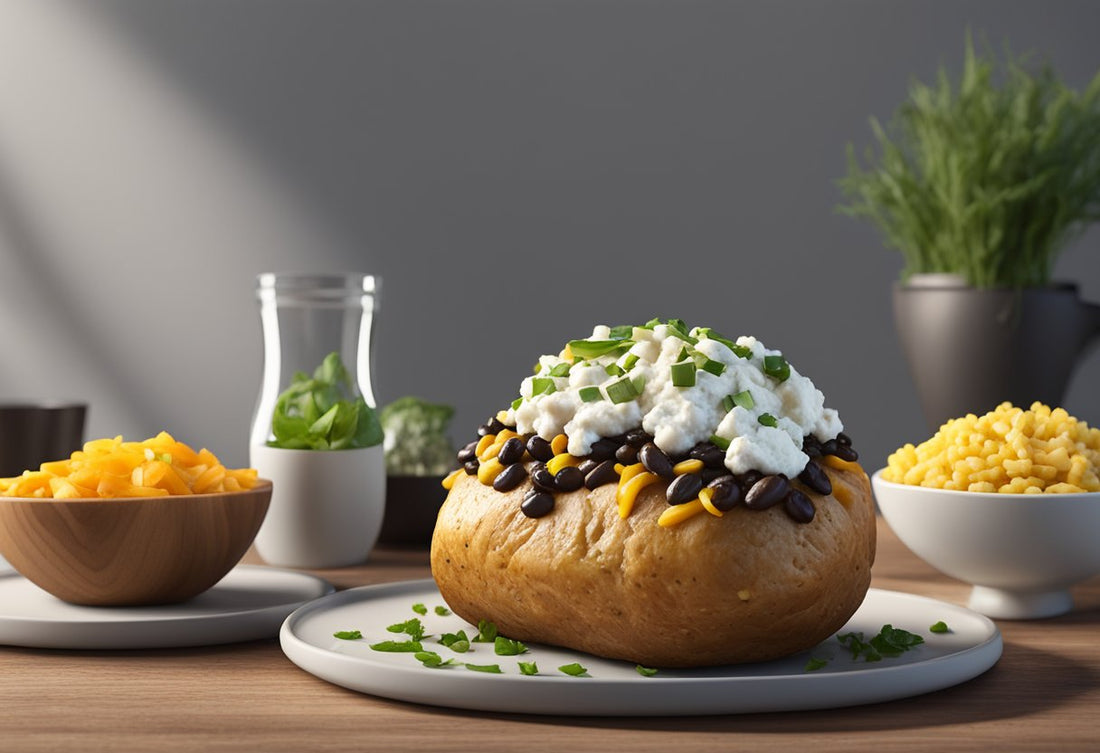
Loaded Jacket Potato
Share
Jacket potatoes are massively popular as of late, thanks to the magic of social media, we are seeing a huge wave of spud-tacular recipe ideas.
Jacket potatoes are a classic comfort food that many of us enjoy. They are simple to prepare and can be topped with a range of delicious ingredients to suit your taste buds. However, if you're looking to add more protein to your diet, you may be wondering how to make your jacket potatoes more nutritious.

Luckily, there are plenty of ways to turn your jacket potatoes into a high protein meal that will keep you feeling full for longer. In this article, we'll share three delicious and healthy high protein jacket potato recipes that you can try at home. Whether you're a meat-eater or a vegetarian, there's a recipe here for you. So, let's get started!
Selecting the Ideal Potatoes

When it comes to making jacket potatoes, selecting the right type of potato is important. You want a potato that will hold its shape while baking and have a fluffy, soft texture on the inside. Here are some tips for selecting and preparing the ideal potatoes for your high protein jacket potato recipes.
Types of Potatoes
There are several types of potatoes that are suitable for making jacket potatoes. Baking potatoes, such as Maris Piper and King Edward, are the most commonly used potatoes for this dish. These potatoes have a high starch content and a dry, fluffy texture when baked. Sweet potatoes can also be used for a different flavour profile and added nutrition.
Preparation Tips
Once you have selected your potatoes, it's important to prepare them properly. Here are some tips to ensure your potatoes turn out perfectly:
- Wash your potatoes thoroughly before baking to remove any dirt or debris.
- Pierce the skin of the potatoes with a fork to allow steam to escape during baking.
- Rub the potatoes with a bit of olive oil and sprinkle with salt for added flavour.
- Place the potatoes directly on the oven rack or on a baking tray and bake at 200°C for about an hour, or until the skin is crispy and the inside is soft and fluffy.
By following these tips, you can ensure that your potatoes turn out perfectly for your high protein jacket potato recipes.
High-Protein Toppings and Fillings
If you're looking to add some protein to your jacket potato, there are plenty of delicious options to choose from. Here are some animal-based and plant-based protein toppings and fillings to consider.
Animal-Based Protein Options
-
Bacon: Crispy bacon bits are a classic topping for jacket potatoes. Not only does it add a delicious smoky flavour, but it also contains protein.
-
Egg: A boiled or scrambled egg is another great animal-based protein option for your jacket potato. It's a simple and easy way to add some extra protein to your meal.
-
Tuna: Tuna is a popular choice for jacket potato fillings. It's high in protein and can be mixed with other ingredients like mayo, sweetcorn, and spring onions for added flavour.
Plant-Based Protein Options
-
Black Beans: Black beans are a great source of plant-based protein and can be used as a filling for your jacket potato. Top it with some salsa and grated cheese for a tasty and nutritious meal.
-
Chickpeas: Chickpeas are another plant-based protein option that can be used as a filling. Mash them up with some avocado, lemon juice, and salt for a delicious and healthy topping.
-
Vegan Cheese: If you're looking for a dairy-free protein option, vegan cheese is a great choice. There are many different types of vegan cheese available, from cheddar to mozzarella, so you can choose the one that suits your taste.
Overall, there are plenty of options for adding protein to your jacket potato. Whether you prefer animal-based or plant-based protein, there's a topping or filling that will suit your taste and dietary needs.
Cooking Techniques

When it comes to cooking jacket potatoes, there are several techniques you can use to achieve a perfect, fluffy baked potato. In this section, we'll explore three popular methods: oven baking, microwave cooking, and alternative methods.
Oven Baking
Oven baking is the most traditional method of cooking jacket potatoes. Preheat your oven to 200°C (400°F). Rub your potatoes with a bit of olive oil and sprinkle them with salt. Pop them in the oven on a baking tray and bake for about an hour. You'll know they're done when the skin is crispy, and the inside is soft and fluffy. For a faster cooking time, you can use a convection oven or an air fryer.
Microwave Cooking
Microwave cooking is a quick and easy way to cook jacket potatoes. Prick the skin of the potato a couple of times all over - this stops it from bursting whilst cooking. Rub the potato skin in a little oil, about 1 tablespoon is plenty. Sprinkle over a pinch of salt and place the potato on a microwave-safe plate. Microwave on high for 5-7 minutes, or until the potato is soft and cooked through. You can also use a microwave potato bag to cook your jacket potatoes.
Alternative Methods
If you don't have an oven or a microwave, there are alternative methods you can use to cook jacket potatoes. One option is to use a slow cooker. Simply wrap your potatoes in foil and place them in the slow cooker on low for 6-8 hours. Another option is to cook your potatoes on a barbecue. Wrap them in foil and place them on the grill for 45-60 minutes, turning occasionally.
Overall, there are several techniques you can use to cook jacket potatoes. Whether you prefer oven baking, microwave cooking, or an alternative method, with a bit of know-how, you can achieve a perfectly fluffy baked potato every time.
Flavour Enhancements

When it comes to adding flavour to your jacket potatoes, there are a variety of options available. Here are some flavour enhancements that you can use to make your jacket potatoes more delicious and satisfying.
Herbs and Spices
One of the easiest ways to add flavour to your jacket potatoes is by using herbs and spices. Some popular options include salt, black pepper, garlic, and a variety of herbs such as rosemary, thyme, and oregano. These can be added to the potato before baking or sprinkled on top after cooking.
If you want to add a bit of tanginess to your jacket potato, you can also try adding a squeeze of lemon juice or a sprinkle of lemon zest. This adds a fresh, bright flavour that complements the earthy taste of the potato.
Sauces and Dressings
Another way to add flavour to your jacket potatoes is by using sauces and dressings. Salsa is a great option, as it adds a lot of flavour without adding a lot of calories. You can also try using a bit of soy sauce for an umami flavour, or drizzling some olive oil on top for a rich, savoury taste.
If you're looking for something a bit creamier, you can try adding a dollop of sour cream or Greek yogurt. These add a nice tanginess to the potato and help to balance out any spicy or savoury flavours.
Overall, there are many different ways to add flavour to your jacket potatoes. By experimenting with different herbs, spices, and sauces, you can create a delicious and satisfying meal that is high in protein and packed with flavour.
Serving and Presentation

When it comes to serving jacket potatoes, presentation is just as important as the filling. Here are some tips to make your jacket potatoes look as good as they taste.
Accompaniments
Jacket potatoes are typically served with a variety of accompaniments. Some popular options include:
- Coleslaw: A classic side dish that pairs well with the rich and creamy texture of the jacket potato.
- Peas: A simple yet delicious side dish that adds a pop of colour to your plate.
- Sweetcorn: Another colourful option that adds a hint of sweetness to your meal.
- Mushrooms: A savoury and earthy option that pairs well with a variety of fillings.
When choosing your accompaniments, consider the flavours of your filling and choose sides that will complement it well.
Plating Techniques
When it comes to plating your jacket potato, there are a few techniques you can use to make it look more appealing:
- Slice it down the middle: This creates a nice opening for your filling and makes it easier to eat.
- Fluff up the potato: Use a fork to fluff up the inside of the potato, creating a nice texture that will hold your filling in place.
- Add a pop of colour: Top your jacket potato with a colourful garnish, such as chopped tomatoes or fresh herbs.
Finally, don't forget about presentation. Serve your jacket potato on a nice plate or bowl, and use a saucepan or other decorative container to hold your accompaniments. With these tips, your jacket potatoes will look just as good as they taste.
Nutritional Information and Benefits

Jacket potatoes are a great source of carbohydrates, fibre, and potassium. They are also low in fat and calories, making them a healthy and satisfying meal option. Here's a breakdown of the nutritional information and benefits of jacket potatoes.
Calorie Count
A medium-sized jacket potato with skin contains approximately 150-200 calories. This makes it a low-calorie meal option that can help you maintain a healthy weight. However, the calorie count can vary depending on the toppings you choose to add.
Macronutrient Breakdown
Jacket potatoes are a good source of carbohydrates, which provide energy for the body. A medium-sized jacket potato contains around 37 grams of carbohydrates. They are also low in fat, with less than 1 gram of fat per serving. Additionally, jacket potatoes are a good source of fibre, which helps to keep you feeling full and satisfied.
Iron and Potassium
Jacket potatoes are also a good source of iron and potassium. Iron is important for the production of red blood cells, while potassium helps to regulate blood pressure and maintain a healthy heart. A medium-sized jacket potato contains around 3.2 milligrams of iron and 926 milligrams of potassium.
Nutrition and Health Benefits
Jacket potatoes are a healthy meal option that can provide a range of nutrients. They are also versatile and can be topped with a variety of healthy ingredients, such as beans, vegetables, and lean protein sources. By choosing healthy toppings, you can increase the nutritional value of your jacket potato meal.
In summary, jacket potatoes are a healthy and satisfying meal option that can provide a range of nutrients. They are low in fat and calories, high in carbohydrates and fibre, and a good source of iron and potassium. By choosing healthy toppings, you can make your jacket potato meal even more nutritious.
